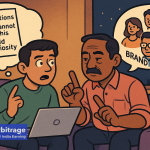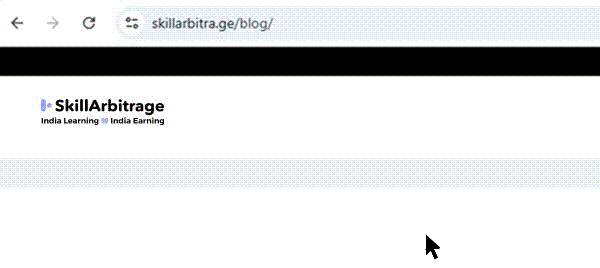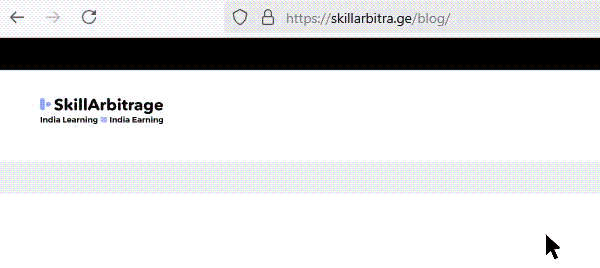This blog will help you figure out which leads are serious and which ones are just wasting your time so that you can stop chasing the wrong people and focus only on the ones who are going to buy.
Table of Contents
Introduction
If you are in sales, you must have also faced this problem. A lead messages you saying they are “interested,” after which you spend 30 minutes answering their questions and sending them a proposal. You wait for them to buy, but all you get is silence.
They either ghost you directly or indirectly by saying, “I’ll get back.” In the end, you are sitting there thinking, “Should I follow up again?” because you have already put in effort and wasted time.
But what if I tell you that you don’t need to get stuck at that point ever again? What if you had a magical ability to spot in the first few chats, whether a lead will actually buy or not?
If it sounds good to you, let me tell you that serious buyers behave very differently from time-wasters, and it is completely possible to identify them beforehand. There are 7 signs that you need to spot, and you will successfully make yourself immune to the “I’m interested” trap.
In this blog, I will show you exactly what to look for to differentiate a serious buyer from a time-waster, but first, it is very important to know why it is even necessary.
Why is it important to qualify leads early?
You also must have realised this fact by now that not all leads are worth your time and efforts. Some people will ask 10 questions, act super interested, and still never buy, while some people will buy without asking anything.
This is why you need to spot the time-wasters early, or else they will waste your time, drain your energy, and leave you doubting your own offer. See, your time is limited. You only have a limited number of hours in a day to talk to leads, pitch them, follow up, and close.
So, if you spend that time with the wrong people, don’t you think you will be stealing time from the right ones? It is immoral in my view, as you will not be able to help the right people who actually want to buy what you are selling.
And want to know the worst part about all of this? The wrong leads don’t just waste time, but they also kill momentum.
You will chase them, wait for their replies, follow up repeatedly, and still get nothing. During that time, a serious buyer might have messaged you, but you missed it or made them wait because you were too busy “nurturing” a dead lead.
That is exactly why qualifying leads early is not just smartbut the need of the hour for anyone in sales. You don’t want to find out at the end that they were never going to buy. You want to know that in the first five minutes.
And once you do get to find that out, you will stop chasing, start closing, and finally feel like your sales process is under control.
Now that you understand why it is important to qualify a lead, it is time I show you the 7 signs you need to spot to know if a lead is worth your time or not.
Sign 1 – They have a clear problem they want to solve
The biggest sign that a good lead will have is that they won’t need much convincing that they have a problem. They will already agree that there is a problem that they want to solve. They might have also tried a few things, failed, and now they are just searching for a solution.
These kinds of leads will need the least amount of your time and effort to get closed. They are a dream lead because they are already halfway into buying, and they are just waiting for the right solution, which is your job to prove it’s you.
Compare that to a time-waster. They will say something like, “I’m just exploring options…” or “We’re not sure if we need this yet…” This is an indirect way of saying, “I’m not serious, just curious.”
Let me tell you the hard truth. If a lead cannot clearly explain the problem they are facing and trying to solve, they are not going to buy anytime soon.
And it’s not your job to spend hours of your time and energy trying to give them that clarity, because you can spend that same time and energy on serious leads to get sales easily and much faster.
You need to understand that people who don’t know what they want will not buy fast. They will need education, hand-holding, and multiple follow-ups, and even then, they will ghost you.
Because if they themselves don’t feel the problem yet, they won’t be much inclined towards the solution.
On the flip side, leads that know they have a clear problem will be urgent, decisive, and way more likely to close.
Think of that yourself. Will you buy a water bottle much faster when you know that you are thirsty and need it, or will you buy a water bottle when you are not thirsty?
In the first case, you know clearly what the problem is, so you will have the urgency to solve it. In the second case, you are not thirsty, so you will need someone to explain to you, “Buy this water because you may not be thirsty now, but sometime later, you might be.”
Now, there are many ways you can identify such leads, mostly by talking to them for just a few minutes. But if you want a clear set of stuff to look for, then look for these:
- They mention the exact consequences that they are facing because of the problem. For example: “We’ve been dealing with lost revenue/delays/stress/inefficiency for a while now.”
- They bring up past attempts that they tried to solve that problem, maybe by themselves or by any of your competitors. For example: “We’ve tried doing X, but it didn’t work. We need something better.”
- They sound a bit frustrated or impatient while talking about the problem because they are feeling the pain right now. For example: “It’s starting to affect our results/revenue/workflow. We need a fix, fast.”
- They don’t just ask what you offer, but they ask if your offer can solve their specific problem. For example: “Our conversion rates dropped after the last update. Can your solution fix that?”
If any of these occur, take it as a green light because that is a lead you should put your focus on. What can you do once you spot them? Simply double down and ask more questions related to their pain so that they open up and recite their problem, hence feeling it again.
Once you feel they have recited their problem and pain, pitch your offer as a solution to the exact pain that they mentioned. Show them that your offer is the solution they have been waiting for. And that is how you close that deal.
Sign 2 – They ask serious and specific questions
One of the biggest signs that a lead is actually serious about buying is the kind of questions they ask. A good, serious buyer will always ask you specific and detailed questions. They won’t stay on the surface and ask generic questions.
They won’t just casually say things that any random guy could ask, like “Tell me more about this…” or “What’s the price?”
These are generic questions that are usually asked by people who are just window shopping and gathering information without any real intention of taking action.
Serious buyers, on the other hand, will ask you very different kinds of questions. They will dive deeper and ask something that will only be relevant for them because they are already trying to imagine exactly how your offer will fit into their situation and solve their problem.
They are not just randomly checking your features and pricing, but they are qualifying you to see if your solution is the perfect match for them.
Let me explain this to you with an example –
Try to remember when you were buying a car. Were you asking, “What does it cost?” or were you asking specific questions that would only stay relevant for you, like “Does it have enough space in the backseat for two kids?” or “What’s the mileage when driving in the city?”
I hope you now understand why it matters when a lead asks serious, specific questions. Because it shows the lead is mentally engaged. They are already imagining how your product or service fits into their life. And the more they imagine it, the closer they are to buying.
Let me show you a few examples of how these questions look like so that you can get an idea of what I want to convey –
- “How long does onboarding usually take?”
- “Can your product integrate directly with [a tool they already use]?”
- “What kind of results have your previous clients achieved?”
- “How do you compare against [competitor] on this specific feature?”
- “We will scale our team in the next 6 months; can your service help with that easily?”
- “Can this particular part of your solution be customized to fit our unique workflow?”
Notice how none of these are random questions. They are thought-through, specific, and directly related to their real-life situation. But how do you clearly tell the difference between a generic question and a serious, specific question?
Simply ask yourself, “Could ‘anyone’ ask this, or is this ‘uniquely’ tied to someone’s exact situation?” whenever a lead asks you a question. Look at the difference it makes so that you understand better:
- “What’s the price?” or “Which pricing plan makes sense if we have 5 salespeople?”
The first question is generic and anyone could ask it. But the second question is very specific and clearly tied to a scenario that might be relevant to that individual specifically.
Both the questions mean the same thing, and the answers are also the same, but the way they’re asked shows whether the lead is serious or not.
- “Tell me about your product,” or “How does your solution handle real-time updates if we have thousands of transactions per hour?”
The first question is generic and shows very little intent. But the second question is extremely detailed and connected to their needs. Both the questions mean the same thing, but the way it’s asked shows whether the lead is a time-waster or not.
Always remember that the more precise, tailored, and situational the question, the more serious and closer to making a decision the leads usually are. But what exactly should you do when you hear such serious and specific questions from a lead?
First, match their level of detail and clarity. Don’t give vague answers to deep questions; instead, respond clearly, honestly, and with relevant examples.
Then, turn the conversation around to ask them clarifying questions in return. This will show them that you are equally serious about solving their problem. For example, you might ask:
- “What tools are you currently using?”
- “What’s your biggest blocker or pain-point right now?”
- “Have you tried solving this in other ways before?”
These questions will also help you gather more insights into their exact needs. Finally, use their specific questions as your opportunity to position your offer as the perfect fit for their situation.
Don’t just talk randomly about features; instead, connect the dots between their exact situation and your solution.
Always remember that if you are getting serious, detailed questions, then you are no longer just talking to a random lead, but you are in the final stages of a sale. So, go ahead and make the most of it.
Sign 3 – They respond quickly
One of the simplest ways to identify if a lead is serious or just wasting your time is by looking closely at how quickly and clearly they reply. The reason is that real buyers who genuinely want to buy will never leave you hanging for days.
If a lead regularly disappears for 4-5 days and then casually replies, “Sorry, got busy,” they are most likely not serious. Because we all know nobody is that busy.
People find time for food no matter how busy they are. So, if your lead considers their problem as a “real” problem, they will find time to look for solutions.
Think of your own behavior. When you really want to buy something, maybe a phone, a course, or a service, do you delay responding to messages for days or ignore calls? Of course not. You reply immediately because you actually want it.
And that is exactly how serious buyers act. One more thing, it’s not that the people who reply slowly won’t buy. They might also buy. But they will actually take a lot of time and effort. And our goal is to get leads who don’t waste our time.
If you have to chase someone for replies, then it should already be a clear sign to you that they are probably not buying because the problem is not that serious for them.
Let me help you clearly spot the difference between good leads and time-wasters by showing some red flags you should immediately watch out for:
- The lead vanishes
If the lead completely vanishes right after you’ve explained your product or sent a proposal, it usually means they are not really interested. A real buyer wouldn’t just disappear after learning the details. For example:
Suppose you finished a demo call and sent the proposal. Suddenly, the lead stopped replying completely for days, even after you followed up again. Then, that means you should not waste any more time following up, as that is not a good lead.
In this case, a good lead will always respect your time and communicate clearly to let you know when to expect their detailed reply, even if they can’t reply fully immediately. For example:
You send them details, and they reply, “Thanks! Currently in meetings, but will reply properly by tomorrow afternoon.”
- The lead reschedules
If the lead constantly reschedules the meeting or conversation, then that is usually a polite way of saying they don’t see your offer as a priority. One genuine scheduling issue is fine, but repeated delays usually mean they are not much interested.
For example: Your lead schedules a call for Monday, then says, “Sorry, something came up, can we do it Wednesday?” On Wednesday, they again ask, “Can we push this to Friday?”
In this case, a good lead will always confirm meetings clearly, show up on time, and proactively follow up. They will also actively reach out if they need more details or clarity instead of forcing you to chase them. For example:
They will say things like, “Just confirming our call tomorrow at 2 PM, I’ll be there.” And after the call, they might even say, “Could you also send over the detailed pricing document? I’d like to review it tonight.”
- The lead sends short-vague replies
If the lead sends you short and vague replies with no clear details, then that often means they are politely brushing you off. If someone really wants your solution, they will be more engaged and descriptive than you and not send lazy one-word answers.
For example: You ask clearly, “Should we schedule a call?” or “Have you gone through the proposal?” and they just reply, “Let me see,” “Ok,” or “Will check.”
In this case, a good lead will always think about their responses carefully and then give you clear, detailed, and relevant responses. For example:
You ask, “Does our solution fit your workflow?” and they reply with, “Yes, I can see how this would fit our existing tools. Can you confirm if it integrates directly with [their specific tool]?”
These are the signs you should stay aware of, as they mean that the lead might need plenty of time and effort to close, or they are just messing around and wasting your time.
So, now you know how to recognise them, but what exactly should you do when you spot a lead who’s quick and clear?
Simply prioritize them immediately. Keep moving the conversation forward quickly. Schedule the next meeting, ask your next questions, or send the proposal clearly and quickly.
But if you notice a lead constantly delaying, rescheduling, or responding without any real energy, stop wasting your valuable time. Give them one polite follow-up, and if they are still cold or vague, move on fast. Your time is always better spent on leads who are ready to buy.
In short, always remember this simple rule – Buyers show up. Browsers vanish. If someone is already hard to reach now, imagine how painful closing them or working with them will be later.
Sign 4 – They show intent without being chased
Another clear sign that a lead is actually serious about buying is if they show clear intent on their own, without you constantly chasing them around. Let me explain what I mean by it.
Do you always find yourself texting or emailing things similar to “Hey, just checking in. Did you go through the proposal yet?” Then let me tell you something, you are probably the only person who is really interested.
Because a serious lead will always come to you. They will follow up themselves without you needing to remind them again and again. They will proactively ask you things like:
- “Hey, just wanted to check, what’s the next step?”
- “Can you send me the payment link?”
- “How do we get started?”
Because they genuinely want to get help with their pain, and they feel you can help them with it. These statements clearly show that the lead is committed and ready to take action. They have already made the decision, and now they are just waiting for you to finalize it.
You might be wondering why intent even matters. Let me tell you, it’s because real intent is always mutual during a sale that happens quicker and easier.
If you believe you should be the only one sending follow-ups, reminders, and messages, then trust me, you are going to waste your time and energy chasing leads who might never buy or might take months to buy.
But if a lead is proactively following up and moving the conversation forward on their own, then that means they have already decided your solution might be the perfect fit. These leads close faster and require far less effort.
So, why not spend your time and energy on more of these leads rather than the ones that don’t have intent? To help you clearly understand and spot these leads, let me show you exactly what this looks like in real-world scenarios:
- They will follow up with you themselves after meetings or calls. For example: After your call, they will message first, saying, “Thanks for today. What’s our next step?”
- They will directly ask you for the next steps or timelines. For example: “How soon can we start if I confirm by today?”
- They proactively request payment details or contracts. For example: “Please send the payment link or the agreement.”
Now, what exactly should you do when you spot someone showing clear intent? It’s simple. Prioritize them immediately. Don’t slow down their momentum.
Quickly provide everything they need, whether pricing, onboarding steps, payment links, or agreements, so they can get closed before something else comes up.
On the other hand, if a lead keeps going cold, avoids action, or only replies when you chase them, give them just one polite, clear final follow-up like this –
“No worries if this isn’t the right time. Just let me know either way so I can plan things on my end.”
Then, stop chasing immediately and move on. Because chasing someone who shows no clear intent isn’t selling. It’s just begging. And you deserve better than that. There are 8 billion people on the planet. Don’t worry, you will always have people to sell to.
Sign 5 – They take action when asked
The easiest way to test how serious a lead is? Simply ask them to do something small that takes hardly a minute or two. For example:
- “Fill out this quick form.”
- “Watch this short 2-minute video.”
- “Book a convenient time slot for our next call.”
- “Reply back with the info I requested.”
These aren’t big tasks. They are quick, simple actions that a genuinely serious lead would never hesitate to do. Now, if the lead doesn’t even do these small things, then let me tell you that they are probably not serious.
Because if someone can’t spend even one minute doing something they believe is important, how do you think they will take a bigger action later, like paying? Think about it yourself.
Suppose someone says they want to get fit, but they skip every workout and never fix their diet. Would you believe they actually want it? The same logic applies here.
Completing this small action matters because it instantly shows you who’s really interested and who’s just messing around. A serious lead won’t hesitate or delay these small actions because they are already motivated and ready to move forward.
So, to spot good leads from the bad ones, ask your leads to do something small, then ask yourself these 3 simple questions:
- Did they do it quickly, within a few minutes or hours?
- Did they reply clearly, confirming exactly what you asked?
- Did they take action without you having to chase or remind them multiple times?
If the answer to all three questions is YES, you have got yourself a serious lead who is likely to buy easily and quickly. If the answer is NO to even one of these questions, then it’s already clear that they are probably just wasting your time.
Now, what exactly should you do once you notice this behavior? The moment a lead does the small action you asked for, immediately push them to the next step. Keep that momentum going. Get them onto the next call, send the proposal, or move to closing (fast).
But if they keep delaying or ignoring small actions altogether, stop wasting your time. You can politely remind them once, but after that, just move on. Because chasing someone who can’t even take a simple 1-minute action is not worth your energy.
Remember to always test your leads with small, easy actions first because the ones who take quick actions are exactly the ones who’ll actually close the deal later.
Sign 6 – They have a timeline, and it’s soon
Another important sign that tells you if a lead is serious or just wasting your time is if they have a clear timeline, and it’s soon. Let me explain clearly what I mean.
When a lead tells you something like, “We want to decide by the end of this month,” or “We’re aiming to start next week,” where there is a clear timeline and it’s soon, then you should know that they are serious. But why does a clear and short timeline matter so much?
Because when someone gives you a specific deadline, it means their problem is already urgent. It means they have likely discussed this internally, have the budget ready, and are actively in decision-making mode.
Compare this to a vague timeline. When someone says things like, “We’re exploring options right now,” or “Maybe next quarter.” These kinds of phrases should immediately signal a red flag to you.
These leads will take forever to close, if they ever close at all. They will require multiple follow-ups, constant chasing, and way more effort than they are usually worth. A simple waste of time.
Think about this clearly. If your house was on fire, would you say, “Let’s explore our options to find some water soon”? No, you’d find water immediately because the problem is real and urgent. The same logic applies here.
A real buyer has a real problem, and a real problem always comes with a clear timeline to fix it. So, what exactly should you do to spot this clearly and practically? Simply, during your conversation with leads, ask a question similar to these, but what’s relevant for you:
- “When are you planning to make a decision?”
- “Do you have a specific date or deadline for starting this?”
- “By when do you need this implemented or live?”
When they respond to the question, notice clearly if their timeline is specific and close (within days, weeks, or within a month). If it is, then prioritize them immediately because they are showing real urgency and are likely to close fast.
But if not, then be cautious. It doesn’t mean they will never buy, but it does mean they will take much longer. So don’t spend all your energy chasing them. But what should you do after you spot a lead with a clear timeline?
Move quickly. Schedule the next call fast, send the proposal immediately, and push the conversation forward without delays. Don’t slow down their momentum and match their urgency to end up closing the deal.
But if their timeline is vague and unclear, politely ask more clarifying questions once to give them another chance, but if they still keep it vague, then simply stop chasing. You will be better off investing your energy in leads that already have clear timelines.
Sign 7 – They are comparing alternatives but are still engaged with you
The last strong sign that a lead is serious about buying is if they are actively comparing you with your competitors but are still regularly engaging with you.
Now, when most people hear something like, “We’re also talking to other providers,” they panic or feel discouraged. But let me clearly explain why this isn’t a bad thing but actually a positive sign for you.
Think about it. If someone is checking out different providers, doesn’t it mean they have already decided they are definitely going to buy? Correct. They are no longer asking themselves if they should buy it, but they are asking who they should buy it from.
That is a perfect place for you to be, because now your job is not convincing them to buy. Instead, your only job is to clearly show why you will be their best option. But there is one important thing to keep in mind here.
Comparison is only a good sign if the lead is actively staying in touch with you during this stage. If, after comparison, they go silent for weeks, then that is clearly a sign they are losing interest.
But if they keep coming back to you regularly, asking questions, sharing updates, or telling you about their decision process, then that means they are seriously considering you. Let me help you clearly understand what exactly you should look for to confirm this:
- If a lead tells you exactly where you stand in their comparison, then it is a very good sign. It means internally, they have discussed your offer clearly, and now they are seriously weighing you against competitors. They are keeping you updated because they want you to stay engaged and help them choose you.
- If a lead asks you for any specific information like case studies, testimonials, or detailed comparison sheets. This means they have already convinced themselves, and now they are just gathering proof to convince others in their team.
- They openly share feedback about competitors and clearly ask how you compare. If they are sharing exactly what they liked or didn’t like about other providers, it’s because they genuinely want to understand why you’re the better choice.
- They openly share their concerns or objections with you and ask if you can handle them. Many people think concerns or objections mean doubt, but actually, it’s a very positive sign. It means they are genuinely considering your offer and actively thinking about how it will fit into their world.
Each of these points will bring you a lead who is actively engaged and seriously considering you, even while they are comparing alternatives. Now, you might ask why this stage matters so much.
That is because comparison is the final stage before purchase. At this point, they are simply deciding who is the best choice for them. So, if they are talking to you during this stage, you are already extremely close to the sale.
Now, let me clearly tell you what exactly you should do when you spot this.
First of all, never get defensive about your competitors. Be confident, open, and clear. Acknowledge what your competitor does well if needed, but clearly show why your offer is still the best fit for their specific problem.
You can also ask them about their decision-making criteria. You can say something simple like, “Just curious, what’s most important for you when deciding between different options?” This question will help you position yourself clearly and remove objections actively.
Lastly, stay close to them and keep following up without being pushy. At this point, you don’t have to convince them from scratch. Instead, you just need to make sure they keep you in mind and that you’re available whenever they need clarity.
Conclusion
I hope you understand now that most salespeople don’t lose deals because their product is bad, but they lose them because they spend time chasing people who were never going to buy in the first place.
And now that you know what signs to look for, you won’t have to face that problem again.
Because every time a lead messages you from now on, you won’t sit there wondering, “Will this convert or just waste my time?” You will already know, and you will make faster, smarter decisions.
That is exactly how you stop chasing and start closing. Now go use these signs, and from now on, only spend your time where the money is.
FAQs
- What if a lead shows 2-3 good signs but still does not buy?
That can happen. Just because someone shows interest does not mean they will buy 100%. These signs don’t guarantee a sale. Instead, they only increase the probability. Your job is to spot enough green signals early so you can prioritize leads wisely and avoid wasting time.
- What if a lead keeps delaying but still says they are “interested”?
That is a trap. Don’t trust words. Instead, trust behaviour. If their actions don’t match their words, they are not serious. Saying “interested” but vanishing for days means they are not ready. Stop chasing and go where the urgency is.
- What if I disqualified someone too early, and they were actually going to buy?
That is okay. You will miss a few, but you will save hours every week by focusing only on high-quality leads. Sales is not about being perfect. It’s about improving your average. And that happens when you start spending time where the signals are strong.
- Do these signs work for service businesses only?
No. These signs apply to product businesses, coaching, consulting, SaaS, and anywhere people buy. Because at the end of the day, serious buyers always behave like serious buyers. It doesn’t matter what you’re selling.
- How do I stop getting low-quality leads in the first place?
Fix your positioning. If your content, messaging, or offer sounds generic, it’ll attract generic leads. Be specific about who your offer is for, what problem you solve, and who it’s not for. That alone will filter out 80% of the wrong people.
- What if I really need sales and don’t have many leads right now?
Still, don’t chase bad leads. You’re better off spending that time finding new ones than begging uninterested people. Desperation smells. And when leads sense it, they pull back even more. Focus on quality even when quantity is low.







 Allow notifications
Allow notifications
